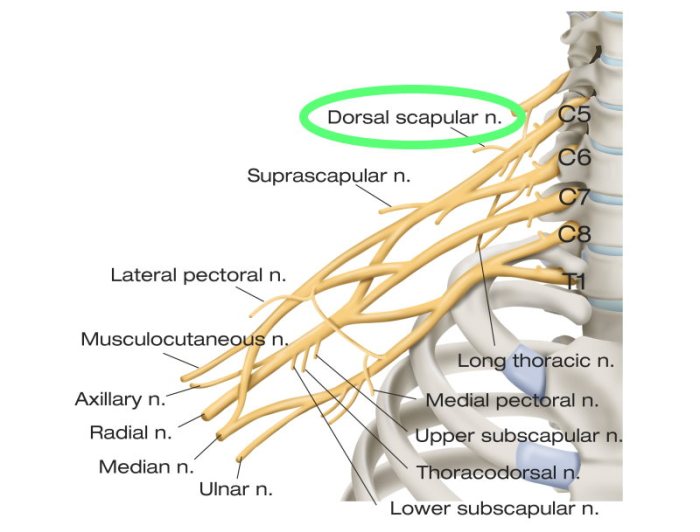The dorsal scapular nerve entrapment test is a valuable tool for diagnosing compression of the dorsal scapular nerve, a condition that can cause significant shoulder pain and dysfunction. This test helps differentiate dorsal scapular nerve entrapment from other shoulder conditions and guides appropriate treatment.
This comprehensive guide provides an overview of the dorsal scapular nerve entrapment test, including its purpose, clinical presentation, physical examination, imaging studies, differential diagnosis, and treatment options.
Dorsal Scapular Nerve Entrapment Test Overview

The dorsal scapular nerve entrapment test is a physical examination maneuver used to assess for entrapment of the dorsal scapular nerve, a branch of the brachial plexus that innervates the rhomboid muscles and the levator scapulae muscle.
The dorsal scapular nerve arises from the C5 nerve root and travels along the medial border of the scapula, supplying the rhomboid major and minor muscles, and the levator scapulae muscle. These muscles are responsible for shoulder elevation, retraction, and rotation.
Anatomical Location
The dorsal scapular nerve exits the intervertebral foramen between C5 and C6 vertebrae and descends obliquely downward and laterally, crossing the levator scapulae muscle and lying deep to the rhomboid minor muscle.
The nerve then courses along the medial border of the scapula, deep to the rhomboid major muscle, and innervates the rhomboid major and minor muscles, and the levator scapulae muscle.
Clinical Presentation of Dorsal Scapular Nerve Entrapment: Dorsal Scapular Nerve Entrapment Test

Dorsal scapular nerve entrapment is a condition that occurs when the dorsal scapular nerve, which supplies sensation and motor function to the rhomboid muscles and levator scapulae muscle, becomes compressed or irritated.
Common Signs and Symptoms
- Pain in the upper back between the shoulder blades, which may radiate to the shoulder or neck
- Numbness or tingling in the upper back
- Weakness in the shoulder muscles, making it difficult to lift or rotate the arm
- Difficulty with overhead activities, such as reaching or lifting objects
Differentiating from Other Shoulder Conditions
Dorsal scapular nerve entrapment can be difficult to differentiate from other shoulder conditions, such as rotator cuff tears or cervical radiculopathy. However, there are some key features that can help to distinguish between these conditions:
- Pain location:The pain associated with dorsal scapular nerve entrapment is typically located between the shoulder blades, while the pain from a rotator cuff tear is usually located in the front of the shoulder.
- Radiation of pain:The pain from dorsal scapular nerve entrapment may radiate to the shoulder or neck, while the pain from a rotator cuff tear typically does not.
- Muscle weakness:Dorsal scapular nerve entrapment can cause weakness in the shoulder muscles, while rotator cuff tears typically do not.
- Overhead activities:Dorsal scapular nerve entrapment can make it difficult to perform overhead activities, while rotator cuff tears typically do not.
If you are experiencing any of the symptoms of dorsal scapular nerve entrapment, it is important to see a doctor to get a proper diagnosis and treatment plan.
Physical Examination for Dorsal Scapular Nerve Entrapment

Physical examination is crucial in diagnosing dorsal scapular nerve entrapment. A comprehensive evaluation includes inspection, palpation, and specific maneuvers to assess nerve function and identify potential entrapment sites.
Provocative Tests, Dorsal scapular nerve entrapment test
- Trapezius Squeeze Test:The examiner stabilizes the patient’s head and compresses the trapezius muscle. If the pain is reproduced, it suggests possible nerve entrapment.
- Shoulder Abduction and External Rotation Test:The patient abducts and externally rotates the affected shoulder while the examiner resists. Pain during this maneuver indicates nerve irritation.
- Posterior Scapular Pinch Test:The examiner pinches the posterior scapular region near the medial border. A positive test elicits pain, suggesting nerve involvement.
Imaging Studies for Dorsal Scapular Nerve Entrapment

Imaging studies play a crucial role in confirming a diagnosis of dorsal scapular nerve entrapment by providing visualization of the nerve and surrounding structures.
Magnetic resonance imaging (MRI) is the preferred imaging modality for diagnosing dorsal scapular nerve entrapment. MRI can clearly depict nerve compression, enlargement, or inflammation, as well as any underlying anatomical abnormalities or masses that may be contributing to the entrapment.
Ultrasound
Ultrasound is another useful imaging technique for evaluating dorsal scapular nerve entrapment. Ultrasound can dynamically assess nerve mobility and compression in real-time, making it particularly valuable for identifying dynamic causes of entrapment, such as muscle tightness or scapular dyskinesis.
Differential Diagnosis of Dorsal Scapular Nerve Entrapment

Dorsal scapular nerve entrapment can mimic the symptoms of several other conditions. It is essential to exclude these potential causes before making a definitive diagnosis.
Other Potential Causes
- Rotator cuff tears:These tears can cause pain and weakness in the shoulder, similar to dorsal scapular nerve entrapment.
- Acromioclavicular joint injuries:These injuries can also cause pain in the shoulder, especially when the arm is raised.
- Cervical radiculopathy:This condition can cause pain, numbness, and weakness in the shoulder and arm due to nerve compression in the neck.
- Thoracic outlet syndrome:This condition occurs when blood vessels or nerves in the space between the collarbone and first rib are compressed. It can cause pain, numbness, and weakness in the shoulder, arm, and hand.
- Myofascial pain syndrome:This condition is characterized by pain and stiffness in the muscles and fascia. It can cause pain in the shoulder that may resemble dorsal scapular nerve entrapment.
Treatment Options for Dorsal Scapular Nerve Entrapment

The treatment options for dorsal scapular nerve entrapment range from conservative to surgical approaches, depending on the severity of the condition and the individual’s response to treatment.
The goals of treatment are to relieve pain, improve range of motion, and prevent further nerve damage.
Conservative Treatment
- Rest: Avoiding activities that aggravate the nerve can help reduce inflammation and pain.
- Ice: Applying ice packs to the affected area can help reduce swelling and pain.
- Physical therapy: Exercises to improve posture, strengthen the shoulder muscles, and improve range of motion can help relieve pain and prevent further nerve damage.
- Medication: Over-the-counter pain relievers, such as ibuprofen or naproxen, can help reduce pain and inflammation.
- Injections: Corticosteroid injections into the affected area can help reduce inflammation and pain.
Surgical Treatment
If conservative treatment fails to provide relief, surgery may be necessary to release the entrapped nerve.
- Endoscopic surgery: This is a minimally invasive procedure that uses a small camera and surgical instruments to release the nerve.
- Open surgery: This is a more invasive procedure that involves making an incision to access the nerve.
The success of surgery depends on the severity of the nerve damage and the individual’s overall health.
Query Resolution
What are the common signs and symptoms of dorsal scapular nerve entrapment?
Pain in the shoulder blade area, numbness or tingling in the back of the shoulder or arm, and weakness in the shoulder muscles.
How is the dorsal scapular nerve entrapment test performed?
The examiner places the patient’s arm in various positions to assess nerve mobility and reproduction of symptoms.
What imaging studies can confirm a diagnosis of dorsal scapular nerve entrapment?
MRI or ultrasound can visualize nerve compression or other underlying causes.